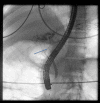Neuroendocrine Carcinoma of the Extrahepatic Bile Ducts: A Case Report
- PMID: 37340629
- PMCID: PMC10290433
- DOI: 10.12659/AJCR.939239
Neuroendocrine Carcinoma of the Extrahepatic Bile Ducts: A Case Report
Abstract
BACKGROUND Neuroendocrine tumors (NETs) primarily originating from the extrahepatic biliary (EB) tree are a medical rarity, accounting for less than 100 recorded instances globally. This case report outlines an encounter with this uncommon condition, demonstrating the complexities of diagnosis and management. CASE REPORT A 42-year-old woman presented at our Emergency Department with a 3-week history of itching and symptoms of obstructive jaundice. Initial laboratory tests showed hyperbilirubinemia and elevated liver transaminases. Abdominal ultrasonography indicated choledocholithiasis. Magnetic resonance imaging suggested either Mirizzi syndrome or a proximal common bile duct neoplasm. Abdominal computed tomography showed cholestasis, suggesting choledocholithiasis or cholangiocarcinoma (type-1). An endoscopic retrograde cholangiopancreatography with biliary and pancreatic duct stenting was performed for drainage, with brush cytology confirming adenocarcinoma. The patient was referred for surgical resection of the bile duct tumor, involving extrahepatic bile duct resection, en bloc cholecystectomy, lymphadenectomy, Roux-en-Y anastomosis, and biliary drainage. Histopathology identified a neuroendocrine carcinoma. Following surgery, the patient underwent eight cycles of FOLFOX6 chemotherapy, with no disease relapse post-treatment. CONCLUSIONS This case emphasizes multidisciplinary teamwork importance in managing rare diseases like EB bile duct NETs. These tumors' rarity and symptom ambiguity necessitate histological examination for accurate diagnosis. This report aims to guide healthcare professionals facing similar future cases.
Conflict of interest statement
Figures





References
Publication types
MeSH terms
Supplementary concepts
LinkOut - more resources
Full Text Sources
Medical
Research Materials

